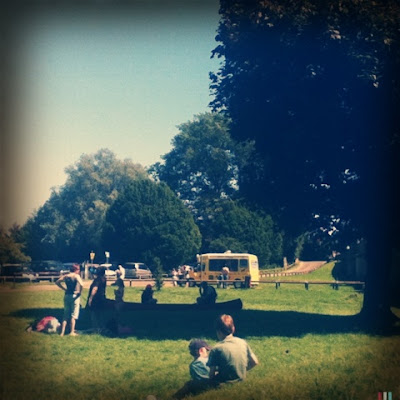I do love Summer and after much trying and pushing to keep up with my Hipstamatic 365 project, it simply wasn't working. I have, however taken a few pictures here and there to capture the summer of 2012 and rather bit them in a slideshow I decided to keep the text short overall for this post and let the pictures do the talking.
Friday, 27 July 2012
Wednesday, 11 July 2012
Absorb and observe...Hindu Wedding
It's almost every girls dream to put on that white dress, feel like a princess for the day and walk an aisle to be re-united with the man that has chosen her to marry. That is how Christian weddings go but over this last weekend, I saw two weddings with a completely different arrangement and culture and that was simply fascinating.
I have stepped up my work experience to assist some Hindu weddings over the next few weekends. Going back 3500 years, many marriages were arranged and the groom would not meet his bride until they were about to be wed. The tradition follows in the same line but with a more relaxed approach where the couple can choose each other, but will be separated by a white sheet until the bride reaches the groom under the Mandap. This is a small covered area held up by pillars where the ceremony takes place (image below taken before the ceremony) It is considered very holy and therefore people under Mandap must not wear shoes, showing their respect to Lord Vishnu. The ceremony is spoken in Sanskrit 'the world's most ancient surviving language' (according to the wedding programme given out on the Sunday ceremony.)
 |
| Mandap |
Not only is this arrangement different but rather than taking half an hour going straight to the vows and 'I do's', there can up be to thirteen different stages that consist over two hour period.
 |
| Var Agaman (welcoming of the groom) |
Stage 1: Var Agaman
The ceremony begins with the welcoming of the groom. In the image above you will be able to see a wooden arch way which is known as the Marriage Pavilion, where the groom is surrounded by his family and friends. The grooms mother then welcomes him by lightly dusting him with red power called kum-kum and rice, which symbolises luck. The groom is the then led to the Mandap for the main ceremony to begin.
Stage 2: Var Puja
The honouring of the groom - before the bride arrives, her parents honour the groom with offerings of Panchamrit (yoghurt and honey) These ingredients represent purity.
Stage 3: Ganesh Puja
All Hindu ceremonies begin calling upon Lord Ganesha. This is done through a prayer to rid of any obstacles that may occur during the ceremony or later in married life.
Stage 4: Mangalashtak
In English this term translates into 'Request for blessings' that includes a eight versed prayer which requests all the gods, goddesses and planets to bless the couple with a harmonious married life.
Stage 5: Kanya Agamanand Puja
The bride now arrives, being escorted to the Mandap.
Stage 6: Jayamala
The white sheet is removed and the bride and groom exchange garlands of flowers.
Stage 7: Hasta Melap
Also known as the 'Joining of the hands', the bride is now given away. The brides father places her right hand on to the groom's right hand which symbolise the respect, responsibility and the love that he has towards her. The brides parents then ask the groom if he accepts their daughter's hand in marriage. In the Hindu culture, this is the greatest gift a person can give.
Stage 8: Vermala
The 'Sacred Thread' is made up of threads of cotton that are placed around the shoulders of the bride and groom. This symbolises the sacred bond of marriage, blessing their happy lives together.
Stage 9: Mangal Fera
'Circling of the sacred Fire' symbolises illumination of the mind, happiness and knowledge. The circuit includes four rotations:
Dharma/Duty
Artha/ Prosperity
Kama/ Love and Family
Mosksha/ Engligtenment
The first three rotations are lead by the groom symbolising his lead to achieve the first three goals. The fourth rotation lead by the bride, shows willingness to achieve the last goal. Once the final round is complete they couple are officially man and wife.
Stage 10: Satapadi
The couple now takes 'Seven Steps' to begin their life together. Each step is a vow:
- To achieve prosperity and help one another fulfil their dreams
- To be lifelong partners and walk through life's obstacles together, to grow in strength
- To preserve each other's wealth
- To share a lifetime of fun and laughter, sorrow and happiness
- To raise a family, to be strong and healthy in mind, body and soul
- To always be honest and faithful to each other
- To be loyal and true to each other, and remain the closest of friends
Stage 11: Mangal Sutra and Sindoor Daan
The groom gives the bride black beaded necklace that symbolises their sacred love union. He now places stindoor (red powder) onto the parting of the brides hair which signifies that they are now married.
Stage 12: Akhanda Saubhagawati
Married women from both sides of the family whisper blessing into the brides right ear, before the rest of the immediate family and friends.
Stage 13: Vidai Ceremony
Family and friends bid a farewell to the bride as she embarks on her new life with her husband. This is also known as the "Crying line"
If I have made any errors, please do let me know and I shall change them.
This was a perfect opportunity to explore a different culture.
Labels:
celebration,
Hindu,
Indian Weddings,
July 12,
Mandap,
photography,
religion,
spirituality,
weddings,
work experience
Subscribe to:
Posts (Atom)






